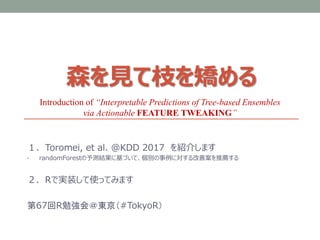Intoroduction & R implementation of "Interpretable predictions of tree-based ensembles via actionable feature tweaking
- 1. 森を見て枝を矯める 1.Toromei, et al. @KDD 2017 を紹介します • randomForestの予測結果に基づいて、個別の事例に対する改善案を推薦する 2.Rで実装して使ってみます 第67回R勉強会@東京(#TokyoR) Introduction of “Interpretable Predictions of Tree-based Ensembles via Actionable FEATURE TWEAKING”
- 2. 学習データのサブセットから構成した 各決定木の予測結果を結合 = 森 分類 → 多数決 回帰 → 平均 予測モデルを組み合わせるアンサンブル法のひとつ ensemble trees Image from: https://ja.wikipedia.org/wiki/%E6%A3%AE%E6%9E%97
- 4. 各木の予測結果を結合 = 森 Image from: https://www.youtube.com/watch?v=KIP2N5HZRW8 ensemble trees 決定木の過半数 が negative と予測 → 多数決により、negative と判断する(予測を多数決する場合)
- 5. @ CRAN CRAN Task View: Machine Learning & Statistical Learning >Random Forest >Boosting and Gradient Descent CRAN Task View: Machine Learning & Statistical Learning https://cran.r-project.org/web/views/MachineLearning.html ensemble methods
- 7. 感度分析(Partial Dependency Plot) 予測モデルを作った後は... 各変数の動き vs 予測値の平均の動き を可視化する 各特徴量の感度分析 in ”forestFloorパッケージを使ったrandomForestの感度分析” https://www.slideshare.net/kato_kohaku/sensitivity-analysis-usingforestfloor ICEboxパッケージをつかったPDPの分解randomForestパッケージのPDP
- 9. 貢献度(XGBoost版) xgboostExplainerによる各特徴量の貢献度の可視化 in “xgboost の中を覗いてみる“ https://qiita.com/vascoosx/items/efb3177ecf2ead5d8ce0 予測モデルを作った後は...
- 10. 欠損値の補完 missForestによる欠損値補完 in “Imputation of Missing Values using Random Forest” https://www.slideshare.net/kato_kohaku/imputation-of-missing-values-using-random-forest @TokyoR#53 ちょっと変わった使い方...
- 11. INTERPRETABILITY • その入力→出力(予測)は、何故/どうやって得られたのか? • その入力→出力(予測)は、何を意味しているのか? Image from: https://www.youtube.com/watch?v=KIP2N5HZRW8 予測モデルの解釈性
- 12. 利用者に納得感を与える変数選択法 LASSOの別解を与える in “Introduction of "the alternate features search" using R” https://www.slideshare.net/kato_kohaku/introduction-alternate-featuresinlassor-71186764 @TokyoR#58 例えば...
- 13. 正則化によるルール縮約 • randomForestでルール生成 • LASSOでルールの刈込み 原著:Friedman & Propescu (2005) http://statweb.stanford.edu/~jhf/ftp/RuleFit.pdf 著者らによるR実装 http://statweb.stanford.edu/~jhf/R_RuleFit.html 紹介記事 https://www.datasciencecentral.com/profiles/blogs/using-rulefit-ensemble-models-is-about-to-become-very-important randomForestと解釈性
- 14. バスケット分析によるルール抽出・要約 ランダムフォレストにバスケット分析 in “Interpreting Tree Ensembles with inTrees” https://www.slideshare.net/kato_kohaku/interpreting-tree-ensembles-with-intrees @TokyoR#51 defragTreesも良い ...が、R実装がない randomForestと解釈性
- 15. Toromei, et al. @KDD 2017 (https://arxiv.org/abs/1706.06691 ) Actionable FEATURE TWEAKING
- 16. Wants どの変数をどう変えたら予測が変わるか? Modified from: https://www.youtube.com/watch?v=KIP2N5HZRW8 Which & How? Actionable FEATURE TWEAKING • モデルの予測を理解できる = 解釈 • ルール抽出 + 感度分析、というアプローチ
- 17. アイデア = 予測結果を変えたい ? X<10 Class= POSITIVE Class= NEGATIVE X=11 YES NO Decision boundary Actionable FEATURE TWEAKING
- 18. アイデア =決定境界の反対側にシフト ? X<10 Class= POSITIVE Class= NEGATIVE X=11-2 YES NO Wants Decision boundary Actionable FEATURE TWEAKING
- 19. アイデア:変更コストが最小の操作を選ぶ Feature i Feature j Class: Positive Class: Negative ε ε ε ε Decision boundary ε 全変数を正規化することで、逸脱パラメータ ε は一つでよい ε-satisfactory instance 決定境界の反対側に ε だけ逸脱するインスタンス候補のうち 変更コストが最も小さい(=最小距離)インスタンスを選ぶ Wants Actionable FEATURE TWEAKING
- 20. アルゴリズム 1. 森モデルによって「望ましくない」ラベルと予測された事例 Xi を拾う 2. 事例 Xi を「望ましくない」ラベルと予測した木を列挙する 3. 列挙した木から、「望ましい」ラベルを予測するパスを列挙する 4. 列挙したパスのうちいずれかについて、事例 Xi から最小の変更量で条件を満たす Xi’ を、変更候補とする 5. 変更候補 Xi’ が森モデルによって「望ましい」ラベルと予測されれば、採択する Prediction by ensemble trees Actionable FEATURE TWEAKING
- 21. 多クラス分類にも自然に拡張可能 Setosa Versicolor Virginica Versicolor Virginica Actionable FEATURE TWEAKING
- 23. R版を作った 1. Ensemble Treesからのルールを抽出する • randomForest 版は実装済み、XGBoost 版は途中まで 2. 推薦パターンを計算する 3. 推薦パターンを可視化する 人工データの負例を正例と予測するように変更する例 ●変更元 → ●変更提案 ( ○正例 ) 作った: FEATURE TWEAKING Rの実装コード → https://github.com/katokohaku/feature_tweaking
- 24. 論文中の適用例 Actionable FEATURE TWEAKING Image from: https://www.youtube.com/watch?v=KIP2N5HZRW8
- 25. “スパム” → “スパムじゃない” に変える 使ってみる: Rなら{kernlab}パッケージのspamデータ
- 26. “スパム” → “スパムじゃない” に変える 手順 1. データのスケーリング 2. randomForestで学習(変数も間引き等を含む) 3. ルールの抽出とε-satisfactory instanceの計算 4. 分析と可視化 5. スケーリングされたデータの復元 使ってみる: Rの実装コード → https://github.com/katokohaku/feature_tweaking
- 27. “スパム” → “スパムじゃない” に変える 使ってみる: 各事例で、どの変数をどちらに動かすか?(=提案パターン)
- 28. “スパム” → “スパムじゃない” に変える 使ってみる: 各提案でどちらに動かしたか?全部で何回変更されたか? e.g. “!” や “$”の多いメールから数を減らせと提案
- 29. まとめ 予測結果に基づいて、個別の事例に対する改善案を推薦する 推薦パターンを集計することで、対象集団全体での変数の意味を評価する 所感 予測モデルは構築されていることが前提 ensemble tree-basedな手法による十分な予測精度が必要 重い 事前にしっかり特徴選択してないと、suggestが多すぎて死ぬ 元論文のアルゴリズムのままだと計算コストが高すぎるので、実装時に見直す必要がある 因果関係ではないことに注意 関連項目の洗い出しができたら、要因分析をすればよいのでは? 操作・介入できない変数に対する配慮は別途必要 年齢や性別などは提案されても変えようがない モデル自体を層別化するとか、禁止リスト等で対処したい Actionable FEATURE TWEAKING
- 30. 参考 • 元論文 • arXiv:1706.06691 [stat.ML] • https://arxiv.org/abs/1706.06691 • 原著者による論文紹介の動画 • https://www.youtube.com/watch?v=KIP2N5HZRW8 • 接点QBさんによる紹介とpython実装記事 • http://setten-qb.hatenablog.com/entry/2017/10/22/232016
